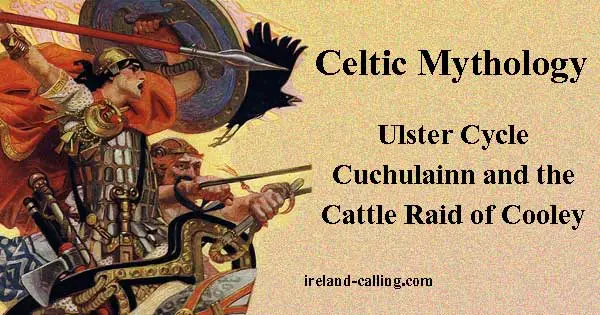The Ulster Cycle is a series of stories from Celtic mythology telling the adventures of legendary figures such as the Irish warrior hero, Cuchulainn, and epic battles such as the Cattle Raid of Cooley, known in Irish as Táin Bó Cúailnge.
It is one the four great cycles of stories from ancient Celtic mythology; the others being the Mythological Cycle, the Fenian Cycle and the Cycle of Kings.
The Ulster Cycle, known in Irish as an Rúraíocht, contains 80 stories about a group of people known as the Ulaid who according to legend, occupied the north east of Ireland more than 2,000 years ago. They gave their name to the province of Ulster.
The Ulster Cycle is set around the reign of King Conchobar mac Nessa. He ruled the Ulaid people from his palace called Emain Macha. This is now the site of Navan Fort near Armagh in Northern Ireland.
The stories in the Ulster Cycle mostly concern the conflict between the Ulaid and the Connachta, people to the west of Ireland in the area still known today as Connaught.
The Connachta were ruled by Queen Mebh and her husband Alill.
Deirdre and Naoise
The stories cover wide ranging themes from heroic feats in battle to love and romance, all mixed in with mundane details of everyday life. For example, the Cattle Raid of Cooley begins with Queen Mebh and her husband Allil chatting in bed about the degree of wealth that each of them brought to the marriage.
This mundane conversation leads on to Mebh raising a huge army to invade the kingdom of the Ulaid to steal away their prize bull. This storyline may seem strange to us now but it must be remembered that cattle were the chief indicator of wealth in ancient Ireland.
One of the best known stories in the Ulster Cycle is the tragedy of Deirdre and Naoise. The story begins just before Deirdre is born. It’s prophesied that she will be a great beauty but this would be a curse rather than a blessing because it would cause kings to go to war over her and lives would be lost. More on Deirdre and Naoise.
How accurate are the ancient manuscripts?
The manuscripts are the only record we have of the stories but they have to be treated with caution.
The Ulster Cycle is also known as the Red Branch Cycle.
It’s thought the monks may have altered or embellished the stories to make them fit better with Christianity or even Roman and Greek mythology. For example, most of the events described in the Ulster Cycle are said to have taken place around the time of Christ. The birth and death of King Conchobar are synchronised with the birth and death of Christ.
It’s unlikely that these similarities existed in the stories handed down in the oral tradition, but we have no way of telling for sure.
It’s also unsure whether the characters in the stories are entirely mythical or whether they were based, however loosely, on real people. There are no written records from those times and scholastic opinion is divided on whether the myths are works of pure imagination or are based on real events.
